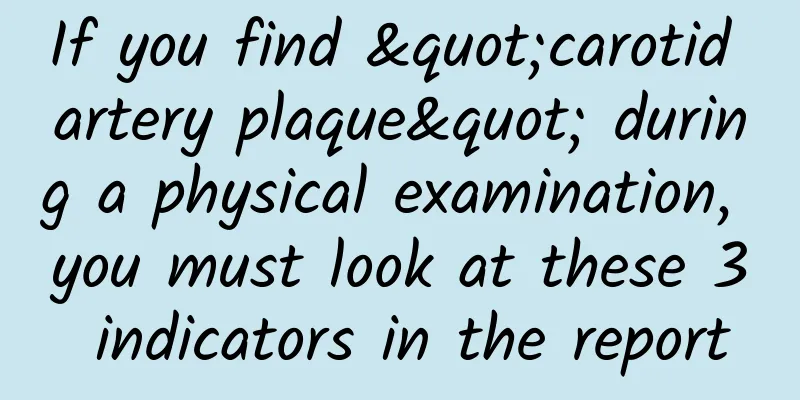If you find "carotid artery plaque" during a physical examination, you must look at these 3 indicators in the report

|
As they age, many middle-aged and elderly people find plaques in their carotid arteries during physical examinations. This sounds scary, after all, the carotid artery is an important blood vessel connecting the head and the body. Once something goes wrong, the consequences are disastrous. But don't worry, today we will talk about carotid artery plaques, see how to judge its severity through simple indicators , and what measures we can take to deal with it . What is carotid plaque? Carotid artery plaque is a manifestation of atherosclerosis. It is like "garbage" on the blood vessel wall. As time accumulates, this "garbage" will accumulate more and more and eventually form a plaque. Image copyright Zeqiao Video According to a study by The Lancet, nearly 2 billion people worldwide are affected by carotid atherosclerosis, with 270 million people in China. More than 40% of Chinese people over 40 have carotid plaques, and almost no people over 60 have no plaques. These plaques may cause blood vessel stenosis, resulting in insufficient blood supply to the brain. In severe cases, they may even rupture and fall off, causing cerebral infarction. Three observation indicators of plaque: How is your carotid artery? When it comes to carotid artery plaque, we can use three key indicators to assess its potential threat to health: 1. Echo Type Strong echo, equal echo (hard plaque) : stable in nature. Mixed echo : unstable, may have tendency to rupture. Hypoechoic (soft plaque) : The most unstable, prone to bleeding, and requires special attention. 2. Blood flow rate The higher the blood flow rate, the greater the obstruction of blood flow by the plaque (the narrower the blood vessel), and the higher the risk. 3. Carotid media thickness (IMT) ****Under normal circumstances, IMT is less than 1.0 mm. Once it exceeds 1.5 mm, it indicates the formation of plaques, and for every 0.1 mm increase in IMT, the risk of myocardial infarction and stroke increases by 15% and 18%, respectively. Can carotid artery plaque be reduced? Carotid artery plaque is not irreversible. Through reasonable intervention, we have every chance to shrink it or even eliminate it. Studies have shown that by controlling low-density lipoprotein cholesterol (LDL-C) below 2.0mmol/L, most plaques will no longer continue to grow; by further controlling LDL-C at 1.5mmol/L, most lipid-rich plaques will begin to gradually shrink. How to prevent and deal with carotid artery plaque? 1. Change bad living habits Improve dietary structure : Reduce the intake of high-cholesterol foods such as red meat and full-fat dairy products, and eat more vegetables, fruits, whole grains, fish, vegetable oils and other foods rich in unsaturated fatty acids to help lower LDL-C. Quit smoking and limit alcohol consumption : Smoking will increase triglyceride levels and lower "good cholesterol" levels; alcohol will stimulate the body, causing cholesterol deposition and leading to atherosclerosis. Regular exercise : at least 3-5 days a week, at least half an hour of aerobic exercise each time, such as brisk walking, jogging, Tai Chi, square dancing, etc. 2. Strictly control the "three highs" Statins : Statins can not only lower blood lipids, but also stabilize plaques and prevent them from rupture. Especially when the degree of carotid artery stenosis reaches 50%, it is particularly important to start statin treatment immediately and control LDL-C below 1.8mmol/L. Antiplatelet therapy : can help prevent blood clots and reduce the risk of plaque rupture. Lowering blood pressure and blood sugar : Controlling hypertension and diabetes, maintaining blood pressure at <140/90 mmHg, and controlling the glycated hemoglobin of diabetic patients below 7.0% can significantly reduce the risk of plaque formation. |
<<: Does elevated transaminase necessarily mean hepatitis?
>>: Return to traditional wisdom: Are you also recalling this "hot potato" in the kitchen!
Recommend
What to do if hypersensitive thyroid stimulating hormone is high in pregnant women
During pregnancy, it is very important for the he...
Medicine Baby Quiz | Can breastfeeding mothers not use antibiotics?
Medicine Baby Analysis The "Guidelines for t...
What causes vaginal pain in late pregnancy?
In the late stages of pregnancy, symptoms such as...
What causes nipple blistering?
Generally speaking, women will choose to breastfe...
Is it okay if the TCT test is positive?
TCT is the general name for liquid-based cytology...
What to do if the fresh embryo is 10 days old?
In vitro fertilization has now become a preferred...
Symptoms of infection after intercourse during menstruation
Everyone knows that it is normal for couples to h...
How much do you know about the six major physical signs of malignant tumors in the body?
Author: Huang Yanhong Duan Yuechu Recently, a res...
What should I do if my urethra is itchy when I urinate?
When urinating, there is pain and itching in the ...
Can I eat before having an abortion?
Can you eat before having an abortion? This quest...
What happens if there is no fetal heartbeat or fetal bud?
In daily life, many pregnant mothers have the pro...
Paris polyphylla pollen is very effective and is a natural anti-cancer agent
Paris polyphylla pollen is an effective anti-canc...
Girlfriend has a headache
The main reason for my girlfriend's headache ...
Benefits of eating more red dates for women
Red dates are one of the most common nourishing f...
Can I eat mung bean porridge during dysmenorrhea?
Dysmenorrhea is too painful, and many girls can&#...









